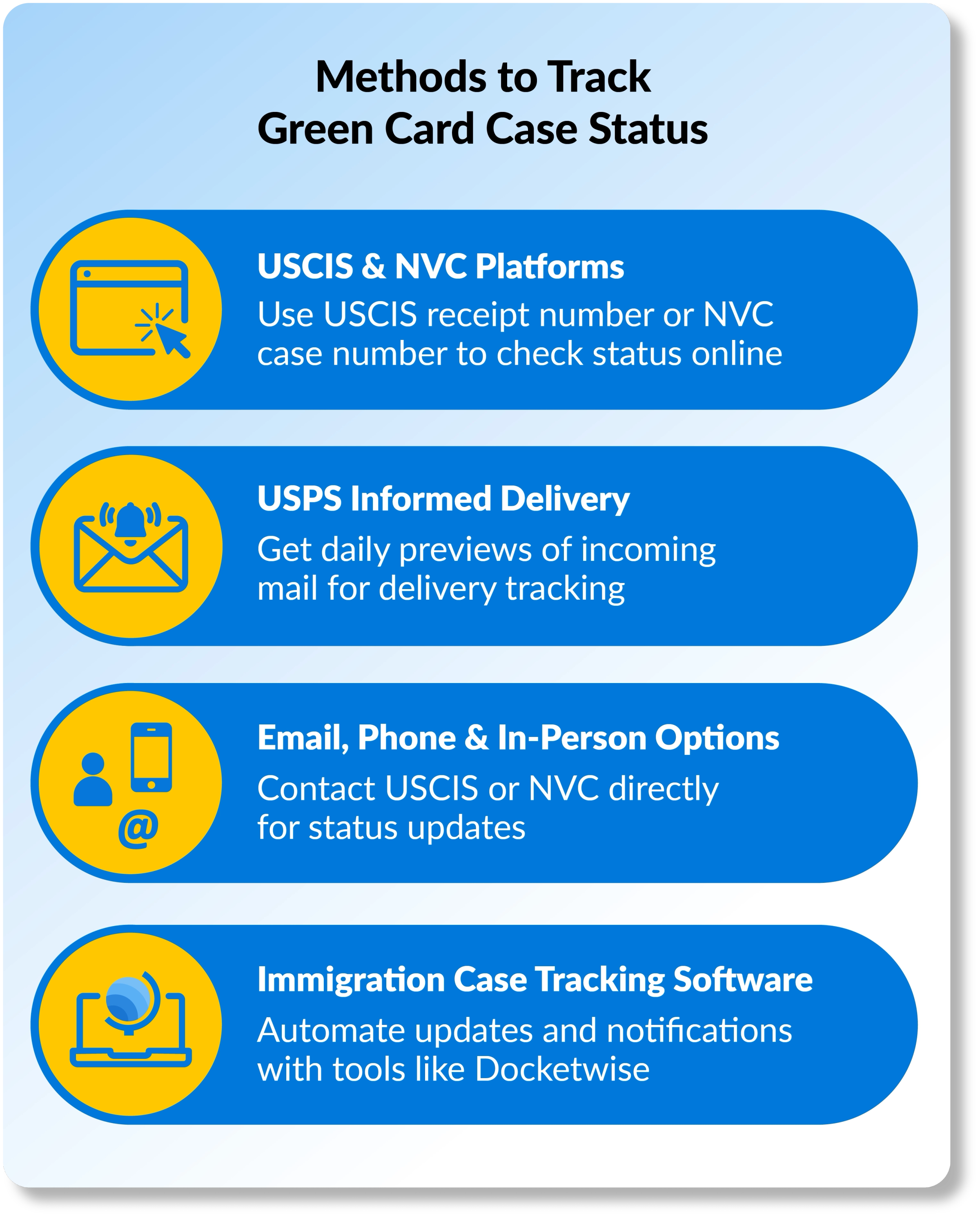Key takeaways
Efficiently tracking green card applications is more critical than ever in 2025 due to growing backlogs and policy-driven delays. While manual tracking methods are available, immigration case tracking software offers automation, centralized updates, and real-time alerts that save time, reduce errors, and enhance the client experience. For law firms managing multiple immigration matters, leveraging technology streamlines workflows, prevents missed deadlines, and empowers clients through self-service portals.
The waiting game for green card applicants can be extreme. Their future rests on receiving approvals and, ultimately, the final document—their permanent resident card, also known as a green card. In this context, process and delivery delays can inspire anxiety and the desire to frequently check in with their lawyer.
Applicant frustrations are likely to increase in 2025 as policy changes extend application processing times and backlogs. Now more than ever, lawyers need to monitor case status closely to put their clients at ease and manage their own administrative burden. Proactive immigration case tracking supports both goals. With real-time tracking, clients gain transparency, and immigration lawyers create meaningful efficiencies.
In this guide, we explain case tracking methods, common pitfalls to avoid, and how immigration technology streamlines case tracking for large and small firms.
Green Card Processing Times in 2025: What to Expect
Green card processing times vary by case type and field office or service center, and can range from one year to three years or more. You can check current processing times for your situation on the official USCIS website. For example:
In Albuquerque, New Mexico, 80% of family-based I-485 applications are completed within 12 months, and in Atlanta, Georgia, 80% are completed within 32.5 months.
80% of employment-based I-485 applications, across all field offices, are completed within 12.5 months.
The Vermont Service Center completes 80% of I-485 applications based on approved T Visas in 38.5 months.
Across all field offices, 80% of I-485 applications based on asylum granted more than one year prior are completed within 15.5 months.
The green card timeline may also be affected by the availability of immigrant visas. There are unlimited visas for immediate relatives of U.S. citizens, but immigrant visas for family-sponsored and employment-based applications are restricted. When demand outpaces supply, a backlog results. The U.S. Department of State (DOS) assigns visas in part based on priority date, which tracks the immigrant's place in line within the backlog.
You can use the visa bulletin to check the availability of a visa number for a given preference category. The May 2025 visa bulletin outlines filing dates and final action dates for family-sponsored and employment-based applications. Dates are additionally categorized by China, India, Mexico, the Philippines, and all other areas.
DOS assigns visas only to applicants whose priority date is before the final action date and accepts document submissions from applicants whose priority date is before the filing date. Final action dates range from April 2011 for F3 family-sponsored applicants from India to the present for certain categories of employment-based applicants. Filing dates range from April 2001 for F4 family-sponsored applicants from Mexico to the present for certain categories of employment-based applications.
How the Trump Administration Has Influenced Green Card Timelines
President Trump began issuing immigration-related executive orders in the earliest days of his second term. Among other things, those orders:
Defined stricter vetting processes for visa applicants
Limited birthright citizenship
Directed DHS to establish new enforcement policies
Prohibited asylum seekers from entering the southern border
Suspended the United States Refugee Admissions Program
Additionally, USCIS is reportedly undergoing major staff reductions as part of Trump's efforts to cut government spending.
The policy-driven increase in scrutiny of immigration applications, combined with USCIS workforce reductions, will likely extend green card processing times in 2025 and beyond. More thorough vetting procedures may increase Requests for Evidence (RFEs) and denials, create backlogs, and disrupt workflows.
A similar trend happened during Trump's first presidential term. A Trump-enacted government hiring freeze created staffing shortages at USCIS that reduced capacity and lengthened processing times. The backlogs created between 2017 and 2020 have continued to affect application timelines into this year.
A closer look at the green card application process shows how easily bottlenecks can arise.
Stages of the Green Card Application Post-Submission
Green card applications go through the following seven stages:
Application submission: The applicant's representative or attorney files an immigration petition by itself or, as appropriate according to preference category and availability of an immigrant visa number, with an application to adjust status. U.S. citizens file an immigration petition I-130 for a non-citizen relative, while an I-140 is filed by a U.S. employer or, in some cases, the non-citizen as a self-petitioner. I-485 is the application to register for permanent residence or adjust status.
USCIS receipt issued: USCIS accepts the filing and issues a Form I-797C Notice of Action to confirm the application has been received. This form includes a 13-character receipt number, which functions as a green card tracking number. You can use the number to check the filing's status online.
Case processing: USCIS runs background checks and collects the applicant's biometrics. If the application is incomplete or questions arise, the agency may issue an RFE.
Approval or transfer: USCIS either approves the case or, for consular processing applicants, transfers it to the National Visa Center (NVC) for visa processing.
Immigrant visa case number assigned: For applicants abroad, the NVC assigns a case number and manages document collection and interview scheduling.
The final decision is made: The applicant receives a green card approval or, for consular processing applicants, immigrant visa approval.
Card or visa mailed: USCIS mails the green card and provides a USPS tracking number. For applicants abroad, the card is mailed after the applicant has been issued an immigrant visa and has used it to enter the U.S.
The process is complex and lengthy. Understanding how to track a green card application through these stages is essential for keeping clients informed.
How to Track Green Card Case Status
You can track a green card application manually or with integrated case management tools. Manual methods include logging onto USCIS or NVC websites, tracking postal deliveries, or requesting updates via email, telephone, or in-person visits. Once you receive a status update, you may also want to record it, along with the date and time you accessed the site, in a spreadsheet or document.
Alternatively, you can use an integrated case management application to receive and record status updates automatically. This is the more efficient and proactive method for tracking green card status and delivery for your immigration clients. You won't miss an update or accidentally delay any necessary follow-up actions.
Below, we’ll review the manual and automatic tracking methods in more detail.

USCIS & NVC Platforms
You can check a case status on the USCIS website or the State Department's Consular Electronic Application Center (CEAC) portal. You can access the USCIS case status tool with the 13-digit green card tracking number from the I-797C notice. Common statuses are:
Case received: The application has been received, but processing has not begun.
Fingerprint fee was received: USCIS has processed the biometrics fee. This must be done before the applicant is scheduled for a biometrics appointment.
Fingerprints were taken: The applicant has completed the biometrics appointment.
Ready to be scheduled for interview: The applicant should receive an interview date soon.
Card was mailed: The green card has been mailed via USPS Priority Mail. The applicant should receive a USPS tracking number.
Note that the USCIS case status tool also provides updates on other case types, such as H1-B petitions. You can view a status update from the CEAC portal using the Immigrant visa case number. You can find the case number on communications received from NVC. Visa case statuses include:
Administrative processing: The application is under review.
Issued: The visa is approved and will be sent to the applicant.
Refused: Further documentation may be needed to complete the application.
USPS Informed Delivery
Learning how to track green card delivery requires knowing about USPS Informed Delivery. This postal service feature provides daily images of mail being sent to you. You can request these notifications via email or text. The images provide an extra layer of tracking when you are expecting important client documents in the mail.
To receive your client's green card and other official communications, you must be established as the client's designated representative via Form G-28.
Email, Phone & In-Person Options
There may be situations that require you or your client to visit or contact USCIS or NVC by email or telephone to get a status update. This typically happens when the client cannot create an online account and has misplaced the case tracking number.
USCIS Contacts
To contact USCIS, call 800-375-5283 Monday through Friday, 8 a.m. to 8 p.m. Eastern Time. The first tier of telephone support can provide status updates, but these representatives have access to the same information available via the case status tool online.
When Tier 1 representatives cannot locate the case with the information you have, they can escalate your question to Tier 2 support or schedule an in-person appointment. Tier 2 representatives can respond via telephone or email.
NVC Contacts
NVC accepts immigrant visa inquiries online here. If the case has already been processed, NVC may refer you back to the U.S. embassy or consulate where the case is located.
Immigration Case Tracking Software
Immigration case tracking software automates and streamlines green card status checks. Docketwise, the all-in-one immigration case management application, receives and records case status updates automatically. The status is logged in the client's profile and client portal, and lawyers managing green card applications receive real-time updates.
With Docketwise, clients and lawyers can stay informed, and lawyers no longer waste time on manual status checks. These automatic status checks also allow for faster identification of issues with green card delivery.
Common Issues With Green Card Delivery and What To Do
Unfortunately, knowing how to track green card delivery doesn't prevent delivery issues. The USCIS case status can indicate the client's green card has been mailed, and USPS tracking can show it has been delivered. But, if you and your client haven't received it, and Informed Delivery hasn't notified you the card is en route, you'll have to research the missing delivery with the post office.
You can initiate a missing mail search through USPS. If that doesn't help, you will notify USCIS that the card has not been received.
Missing Mail Search
USPS recommends completing a help request form before initiating a missing mail search. The help request form goes to the local post office for research. If the mail is not located by the local team within seven days, you can submit a broader search. You can provide this information to request the search:
Sender mailing address
Recipient mailing address
Size and type of packaging
USPS tracking number
Description of contents
Delivery problems often arise from an incorrect or outdated mailing address on file with USCIS. USCIS does not follow USPS mail-forwarding orders, so clients must also provide their new address to USCIS directly. This update can be done within the client's USCIS online account, by contacting USCIS Tier 1 support, or by mailing Form AR-11 to the DHS at 1344 Pleasants Drive in Harrisburg, Virginia 22801.
Managing the client's address with USCIS may require hands-on attention, but status tracking can be automated with immigration case tracking software.
Escalated Inquiry to USCIS
If the postal service cannot locate a card, you can notify USCIS and request a replacement card. To do so, you can complete a form on the USCIS website. Be sure to have the receipt number, A-number if applicable, and filing date.
Benefits of Using Immigration Case Tracking Software
Green card tracker software streamlines status monitoring by eliminating the need for manual checks and expediting client and case file updates. The efficiency and client experience benefits of centralized updates, automated status alerts, and improved client transparency are valuable, particularly for lawyers juggling multiple cases.
Centralize Case Updates Across All Matters
Case tracking software automatically consolidates USCIS updates across all client matters into one centralized system. The software becomes a dashboard where lawyers can track EAD cards, green cards, and other case types. Attorneys have more visibility into what's happening with their case load, plus more free time to focus on case strategy.
Automate Status Alerts and Priority Date Tracking
Real-time, automated status alerts for receipt and green card tracking number changes and visa bulletin priority dates keep legal teams current and minimize the risk of missed deadlines. The tracking ensures cases progress as quickly as possible, elevating the client experience and supporting improved profitability for the firm.
Empower Clients Through Self-Service Portals
Case tracking applications with client portals add more transparency. Clients can log in to their portal and view their case status independently, rather than reaching out to their lawyer for a USCIS update. This reduces inbound inquiries while improving the client experience—a win/win for legal teams.
How Docketwise Helps Lawyers Track Green Cards
Docketwise incorporates two crucial immigration case tracking features to help lawyers and clients track green card applications.
Receipt number tracking: Docketwise automatically checks case status updates using USCIS receipt numbers. In addition to green card applications, you can also track EAD card status and other case types.
Priority date tracking: Docketwise monitors visa bulletin priority dates for preference immigrant green card cases. The application keeps lawyers informed on dates so they can plan filings and prepare clients in advance.
The phrase 'green card tracker' can have different meanings because applications can route through multiple agencies. To clarify, Docketwise provides detailed case tracking for many application types that lead to a green card, including adjustment of status cases. The software does not track cases once they've been transferred to NVC.
USCIS application tracking alone reduces manual work and eliminates missed status changes and visa bulletin updates. Even better, Docketwise incorporates these tracking tools into its comprehensive case management dashboard. As a result, lawyers can manage deadlines and documentation, notify clients, and send alerts from one centralized system. The efficiencies gained from automation combined with centralization are critical for growth-oriented immigration practices, especially for firms handling hundreds of open matters.
To see Docketwise in action, schedule a demo today.
About the author

Catherine Brock
Catherine Brock is a Content Writer for leading legal software companies, including MyCase, Docketwise, and CASEpeer, as well as LawPay, the #1 legal payment processor. She covers emerging legal technology, financial wellness for law firms, the latest industry trends, and more.
